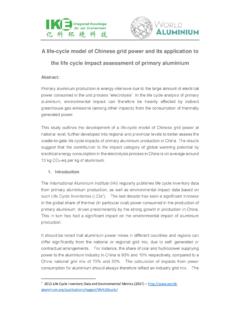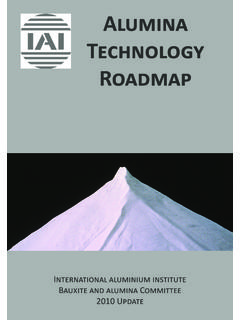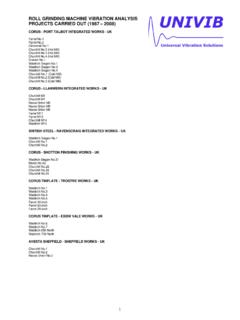Transcription of The Global Aluminium Industry 40 years from 1972
1 The Global Aluminium Industry 40 years from 1972. Dr Carmine Nappi February 2013. Foreword In 2012, the International Aluminium Institute (IAI) a Global forum for Aluminium producers worldwide celebrated its 40th year, having been incorporated on 28 April 1972 as the International Primary Aluminium Institute (IPAI). The term Primary was deleted in 2000, the change reflecting a broader, inclusive agenda and commitment to sustainability along the whole Industry value chain. At the 1972 incorporation, there were 44 member companies; Global primary Aluminium production was less than 12 million tonnes (Mt). A smelter capacity of over 150,000 tonnes was considered to be large; today 500,000 tonne capacities are commonplace and a number of facilities are at or approaching one million tonnes annual capacity. Currently, the IAI has 26. member companies, responsible for around 70% (about 28 Mt) of world primary Aluminium production.
2 The IAI invited Dr Carmine Nappi, Consultant and Industry Analyst, to reflect upon the Global changes and developments within the Aluminium Industry over the period of the existence of the IAI. The contents of this paper reflect the views of Dr Nappi, not the IAI. Dr Carmine Nappi has almost four decades of experience in the metals and mineral economics Industry . Carmine joined Alcan in May 1999 as Director of Industry Analysis and was promoted to the position of Vice President of Industry Analysis at Rio Tinto Alcan in November 2007, where he was responsible for price forecasting and analysis of Aluminium Industry trends. Carmine retired from Rio Tinto Alcan in 2011 and is now consulting in the field of industrial organization. 2 1. Introduction Today, the Global Aluminium Industry has only a bare resemblance to what it was in the early 1970s. The most important structural changes are the geographical relocation of bauxite, alumina and Aluminium production centres; shifts in the degree of concentration and integration; the emergence of new consuming regions, the development of new end-use markets and the threat of substitutes, including recycled metal; the historical decline in real prices of the metal and the recent upward shift in the Industry cost curve; the market adjustment mechanisms and, more recently, the rising popularity of commodities as an asset class.
3 The main objective of this paper is to highlight and analyze these changes over the last four decades. Commencing with an identification of the main characteristics of the Aluminium Industry in the early 1970s, the paper then examines the main forces or drivers that have deeply modified the structure of the Global Aluminium Industry , factors such as energy crises, arrival of new players, variations in exchange rates, shifting trends in Aluminium cost curves, and the role of emerging economies. The main characteristics of current Global Aluminium Industry are then presented, with a view on future demand and production. 2. The Global Aluminium Industry in the Early 1970s The year 1972 saw bauxite production dominated by four countries Australia, Jamaica, Suriname and USSR which together held a 60% Global market share. Today, only Australia is on a list of the top six producers. Even greater changes have occurred in the location of alumina-producing countries.
4 In 1972, more than 45% of Global alumina production was concentrated in five industrialized countries, poorly-endowed with bauxite reserves: United States, Japan, Canada, France and Germany. The other major producers were then Australia (13%), USSR (12%), Jamaica (9%) and Suriname (6%). Today, among the countries mentioned above, only Australia is still a significant producer, with alumina production having generally shifted from industrialized or Aluminium producing countries to bauxite producing regions. Major shifts have also occurred in the geographic location of Aluminium production centres. The combined share of United States, USSR and Japan reached almost 60% of Global primary production in 1972. Today, their corresponding share barely exceeds 10%. Norway, Germany and France have also been replaced on the list of top Aluminium producers. This relocation of bauxite, alumina and Aluminium production centres has been accompanied over the last 40.
5 years by other significant structural and behavioural changes that need to be analyzed. 3 Others Australia 21% 20%. France 5%. USSR. Greece Bauxite ( Mt) 10%. 3%. Guinea 4%. Guyana Suriname 5%. 11% Hungary 3%. Jamaica 18%. Others Australia 14% 13%. Canada 5%. USSR France 12% 5%. Germany 4%. Alumina ( Mt). Jamaica 9%. Japan United States 7%. 25%. Suriname 6%. Australia 2% Canada Others 8%. 18% France 3%. Germany 4%. India 2%. Primary Japan Aluminium ( Mt) USSR. 9%. 16%. Norway 5%. United Kingdom United States 1%. 32%. Figure 1: World Production of Bauxite, Alumina and Aluminium (1972). Source: Derived from World Bureau of Metal Statistics (WBMS), various years 4 Degree of concentration and integration 1955 1971 1979. 2% 12%. 19%. 23%. 5% 28%. 37%. Bauxite 46%. 11% CR6 : % CR6 : % CR6 : %. HH : HH : 14% HH : 8%. 7%. 16% 11%. 26% 5%. 2% 8%. 12% 4% 4%. 10%. 4% 21%. 25% 23% 26%. 5% 28%. Alumina CR6 : % 3% CR6 : % CR6 : %.
6 12%. HH : HH : HH : 11% 5%. 19%. 14%. 27% 9%. 17% 12%. 11% 9% 9%. 14% 17% 15%. Primary Aluminium 20%. 4% 27%. 38%. 6%. CR6 : % CR6 : % CR6 : % 16%. HH : HH : 20% HH : 15% 6%. 26%. 10% 9%. 12% 6%. 15% 8% 8% 8%. 24%. Alcoa 46% Alcan 8%. 7% 5% 8% Reynolds Kaiser Pechiney Alusuisse Others 5%. 1. Figure 2: Market Shares and Degree of Concentration in Global Bauxite, Alumina, & Primary Capacities: 1955, 1971, 1979. Source: Derived from John A Stuckey, Joint Ventures and Vertical Integration in the Aluminium Industry , Harvard University, Cambridge, 1983, 1. Measured by share of the six most important companies (CR6) and HH index (sum of squared market shares). 5 The international Aluminium Industry was dominated in the early 1970s by the Six Majors . Alcoa, Alcan, Reynolds, Kaiser, Pechiney and Alusuisse with a combined share then exceeding 60% for bauxite, approaching 80% for alumina and hovering around 73% for primary Aluminium .
7 Despite this robust degree of concentration, Figure 2 indicates that it was even higher in the mid-1950s (between 85 and 90% at each step of the production process), while towards the end of the 1970s the combined market share of the Six Majors was still significant. An alternative way to measure the degree of concentration is to sum the square of each producer market share (the HH index) in order to give more weight to large players in an Industry and thus better assess the existence of market power. This index is presented in Figure 2. In addition to a high degree of concentration, Figure 2 also suggests that the Aluminium Industry of the early 1970s was highly integrated, since the companies with smelters were operating alumina plants to supply alumina to the smelters and bauxite mines to supply bauxite to alumina refineries. Vertical integration also extended beyond the integration of mining, refining and smelting: the operations of the largest Aluminium companies of that period also embraced the production of downstream fabricated Aluminium products such as sheet & plate, extruded products, wire, cable & tubes and foil.
8 Consumption growth by region and end-use market Given the product characteristics (light weight, strength, moderate melting point, ductility, conductivity, corrosion resistance and barrier properties), Aluminium consumption experienced a compounded annual growth rate (CAGR) of almost 10% over the 1945-1972 period thus exceeding GDP growth, a clear sign of increasing intensity of use of Aluminium per product . gaining ground in building applications, electric cables, basic foils and the aircraft Industry . In the early 1970s, an additional boost resulted from the development of Aluminium beverage cans. Forty- years ago, 62% of Global consumption of primary Aluminium was concentrated in six industrialized Western countries, the United States leading the pack with a market share of , and Japan second at China's share was below in 1972, while about 12%. of Global demand was then concentrated in the USSR. For total Aluminium consumption by end-use, the pattern was quite different by region.
9 Slightly more than 20% of German Aluminium was used by the transportation sector, followed by engineering (18%) and building & construction (16%). Only 9% of Aluminium shipments were directed to the packaging sector. The picture was quite different in Japan where Aluminium demand was dominated by building & construction (31%), followed by transportation and engineering; the Japanese packaging sector was absorbing in the early 1970s less than 2% of total demand. While similar to Japan with building and construction consumption at 26%, the US packaging consumption share was much higher at 6 In each end-use sector, Aluminium was in the early 1970s displacing substitutes, including cast iron, rolled and galvanized steel, tinplate, cast zinc, copper wire and tube, timber, glass, cardboard and metallised paper. The rivalry between substitutes would become harsher in the following decades as consumers continuously assessed not only the functional characteristics of competing materials but also their relative prices.
10 Within the Aluminium sector, the substitution of primary metal by recycled Aluminium metal has been a significant change, with a shift in environmental and social attitudes over the period bringing the Industry to a new paradigm in terms of sustainability and product life cycles. The Aluminium beverage can takes centre stage during the early part of the period under review and further reinforces the development of the Aluminium recycling Industry . According to WBMS data, Aluminium recovered from scrap in Western countries represented in 1972 about 21% of Western World total (primary and secondary) consumption of Aluminium . The latter share remained below 24% until the end of the 1970s. Growth Pace By Region 50,000. 45,000 pa China France 3% 3%. 40,000 Others Germany 23% 6%. 35,000 Italy 3%. 30,000 pa 25,000 Japan 20,000 Mt 10%. United 15,000 USSR Kingdom 12% 4%. 10,000. 5,000. 0 United States 36%. Total Consumption by End Use Transportation Engineering Building & Packaging (Mechanical & Construction Electrical) United Japan Germany United Japan Germany United Japan Germany United Japan Germany States States States States Figure 3: Primary Aluminium Consumption, 1972.






